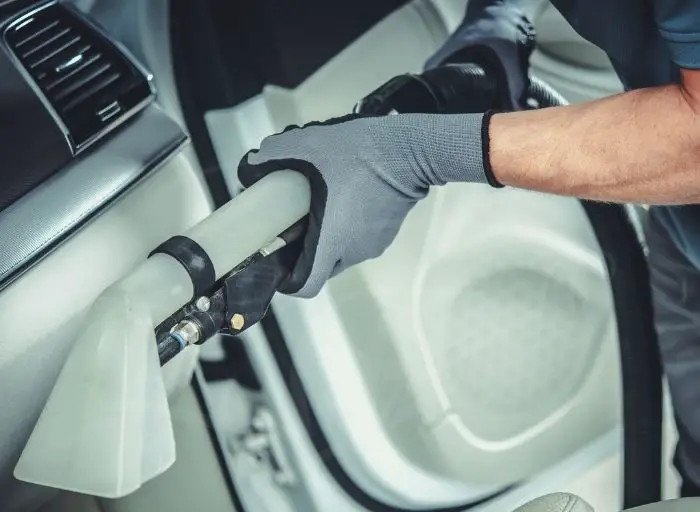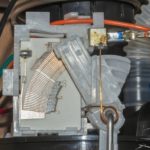
It’s wintertime and your car’s interior is wet after a heavy downpour. It might be tempting to turn on the heat, but that can actually make things worse if water comes into contact with hot hoses or heater coils. Or you leave your windows down and let the rain get into your car. How do you dry out a car interior?
In this blog, I’ll share with you several methods to dry out a wet car interior.
The best and first thing you can do is to start by wiping down the surfaces using a towel or cloth. This will stop any water from soaking in and evaporating, which would only make things wetter over time.
Table of Contents
Common Causes of Water Damage in Car Interiors
Over time, our cars are prone to many external factors like rain. Once water finds its way into the car, it’s imperative to deal with it immediately. Here are some common causes:
Leaking windows or sunroof
One of the primary causes of water damage in car interiors is leaking windows or sunroofs. Over time, the seals around windows and the sunroof can deteriorate or become damaged. When the seals are compromised, water can quickly enter the car’s interior through gaps and cracks, leading to water damage.
Leaking windows or a sunroof is especially problematic during rainstorms, as it can allow rainwater or moisture to seep into the car, potentially damaging the upholstery, carpeting, and electronic components.
Rainwater seepage
Rainwater seepage is another common cause of water damage in car interiors. When driving in heavy rain or parking the car in an area with poor drainage, the vehicle becomes vulnerable to water infiltration. Water can enter through gaps in doors, windows, or other openings in the car’s exterior.
This can be more prevalent in older vehicles or those with compromised weatherstripping or seals. If left unaddressed, rainwater seepage can lead to dampness, mold growth, and damage to the interior materials, affecting the overall comfort and value of the car.
Flood or water damage
Flood or water damage is a severe cause of interior water damage. During extreme weather events, such as floods or heavy storms, water can rapidly enter the car’s interior, causing extensive damage. Driving through flooded areas or parking in locations prone to flooding significantly increases the risk of water damage.
Floodwater can affect the upholstery, carpeting, and vital electrical components. The saturation of electrical systems can lead to malfunctions, corrosion, and potential safety hazards. Immediate action is necessary in these situations to prevent further damage and ensure the vehicle’s and its occupants’ safety.
It’s important to address these common causes promptly to prevent further damage and maintain the integrity of the car’s interior. Regular inspections and maintenance can help identify and mitigate potential sources of water damage.
How Do You Dry Out a Car Interior?
Tools needed to dry wet car interior:
(As I said earlier, towels are good but to dry out the inside of the car faster and more effectively, these tools will be very handy)
- Towels
- Wet/dry vacuum
- Fan/ Hairdryer/ Air blower
- Dehumidifier
How to dry out a car with towels after it rains
The best and most effective way to speed up the drying process is to use towels. Do not use paper towels or toilet paper which can cause more scratches on the car’s interior. If you don’t have any dry towels, you can always grab some from home and bring them with you.
The easiest way to use a towel is to blot the water on the wet surface of your car. Make sure that your towel is completely dry before you use it in another area of the car. This will prevent you from spreading dirt and wetness.
How to use wet/dry vac to dry car carpet & seats

A wet/dry vac is an excellent tool to dry the car’s carpet and seats. This tool works really fast because of its powerful 12-volt motor. However, you will need to use the correct nozzle to dry out the water. If the nozzle is too narrow, it may scratch your seats; too wide will take longer to dry out.
- Choose a wide-nozzle attachment (I like the “fur” attachment).
- Pump the wet vac to circulate the water out.
- Use the vacuum to dry out any residual water till it has evaporated.
- You can use your directional nozzle attachment to help you dry out the water in small areas, like your seats or carpeted console.
How to dehumidify a car using a fan
Dehumidifiers cannot work underwater, so if your car is wet inside, this tool will not work. A fan can blow air to dry out the car’s interior. This portable fan can speed up drying and provide fresher and more comfortable seats and carpets.
- Get the car dry with towels first.
- Use the fan to dry out the wet areas of your car.
- Repeat this process until your car is thoroughly dry.
- It will take about an hour to dry completely with a medium-speed fan, 30 minutes with a low speed, and about 8 minutes if you use a high-speed fan.
If the wet areas are small, you can use a hairdryer or air blower as substitutes.
How to Prevent Mold and Mildew
If the inside of the car is not thoroughly dry, there is a high chance that mold and mildew grow from moisture spots. You can use moisture-absorbent products like Cat Litter or baking soda to prevent this. These will absorb the residual moisture and avoid the growth of mold and mildew.
Cat Litter is a good product to use in cars. It’s made for cats but can also help you eliminate the musty smell in your car.
- Remove all items that are wet or have any moisture content.
- Put dry litter in your car so the floor, seats, and console are covered with cat litter.
- This will help absorb excess moisture so mold and mildew do not grow in your car.
Or you can use baking soda.
- Baking soda is a good absorbent that will take up moisture.
- Empty your car’s floor and put down a layer of baking soda.
- Let the baking soda get wet, then vacuum it to remove the moisture.
- Leave the baking soda in your car for at least 24 hours for it to completely dry out and absorb all excess moisture.
- Wipe off any remaining baking soda and vacuum again.
If you see mold develop, check out this article to learn how to deal with it: How to Remove Algae and Mould From Car!
Techniques to Dry Specific Car Interior Components
Dry the upholstery and fabric surfaces
When drying a wet car interior, one of the first areas to address is the upholstery and fabric surfaces.
Use towels or absorbent materials to soak up as much moisture as possible. Press the towels firmly against the upholstery, seats, and fabric surfaces to draw out the water.
Avoid rubbing or scrubbing, as this can potentially spread the moisture further.
Consider using steam cleaners or wet/dry vacuums designed for automotive interiors for more effective drying.
These tools can help extract excess water and accelerate drying, leaving the upholstery cleaner and drier.
Dry the carpet and floor mats
Carpet and floor mats are prone to absorbing water, making them more challenging to dry.
Begin by removing the floor mats and drying them separately. Shake them to remove any loose water, and then use towels or a wet/dry vacuum to extract as much moisture as possible.
Next, focus on the carpeting. Start by blotting the wet areas with towels or absorbent materials. Apply pressure to draw out the water, repeating the process until the towels come out relatively dry.
Consider using a carpet cleaner with an extraction function to extract deeper moisture.
Dry the dashboard and console
The dashboard and console areas are often made of hard surfaces that can trap moisture.
To dry these areas, begin by wiping down the surfaces with microfiber cloths. Microfiber is highly absorbent and gentle on delicate surfaces. Gently pat and wipe the dashboard and console to remove any visible moisture.
Utilize compressed air for hard-to-reach areas where water may have accumulated. Use a can of compressed air or an air compressor to blow out any trapped moisture.
Be cautious not to use excessive pressure that could damage sensitive components.
Combining these techniques can effectively dry the dashboard and console, preventing water damage and potential electronic malfunctions.
Remember, the key to drying specific car interior components is quickly and thoroughly removing moisture. Adequate ventilation and fans or dehumidifiers can also aid in expediting the drying process. Additionally, addressing any underlying causes of water damage, such as leaks or faulty seals, is essential to prevent future incidents and maintain a dry car interior.
Common Mistakes When Drying Out a Car Interior
Ignoring the source of water damage
One common mistake is solely focusing on drying out the car interior without addressing the source of water damage. If the underlying cause, such as a leaking window or sunroof, is not resolved, the problem will persist, and the interior may get wet again. Identifying and fixing the source of water intrusion is crucial to prevent future water damage.
Insufficient ventilation
Improper ventilation during the drying process is another mistake to avoid. It’s essential to open doors, windows, and sunroofs to allow fresh air to circulate. This helps remove excess moisture and prevent mold and mildew growth. Neglecting proper ventilation can prolong drying and result in lingering odors or potential health hazards.
Neglecting to remove wet floor mats and carpets
Leaving wet floor mats and carpets in the car is a mistake that can impede the drying process. Wet mats and carpets can retain moisture, leading to prolonged dampness and potential mold growth. Removing these items, drying them separately, and thoroughly drying the underlying carpeting to prevent further damage is essential.
Using heat sources inappropriately
Using heat sources such as hairdryers or heaters to speed up the drying process can be a mistake if not used cautiously. Excessive heat can damage sensitive components and upholstery or cause warping in certain materials. Using heat sources at a safe distance and on low settings is important to avoid potential harm to the car’s interior.
Neglecting electrical components
Water damage can pose a risk to the car’s electrical components. Neglecting to inspect and address any potential water infiltration into the electrical system can lead to malfunctions or safety hazards. It’s important to check for water damage, dry and inspect electrical connections, and seek professional assistance.
Rushing the drying process
Attempting to rush the drying process is a common mistake that can result in incomplete drying and lingering moisture. Being patient and allowing sufficient time for the car interior to dry thoroughly is crucial. Properly drying all components and ensuring no moisture remains will help prevent long-term damage and potential issues.
Failing to address odors
Mold and mildew growth can cause unpleasant odors in a car’s interior. Failing to address these odors is a mistake as they persist even after drying.
Avoiding these common mistakes when drying out a car interior will help ensure effective drying, prevent further damage, and maintain the vehicle’s overall condition.
Check out This Video for How to Dry Wet Car Seats Quickly!
Frequently Asked Questions
# Can I use a hairdryer to dry out the car interior?
Using a hairdryer to dry out a car interior can be risky and may not be the most effective method. The high heat from a hairdryer can damage sensitive materials or electronics in the car. It is better to rely on natural air circulation, open windows, and fans to facilitate the drying process.
# How long does it take to dry out a car interior?
The time it takes to dry out a car’s interior depends on various factors, such as the extent of water damage, humidity levels, ventilation, and drying techniques employed. Generally, the interior can take a few hours to several days to fully dry.
# Will my car insurance cover water damage repairs?
Whether your car insurance covers water damage repairs depends on the specifics of your policy. Typically, comprehensive insurance coverage may include water damage repairs caused by incidents like floods or storms.
# Can I use baking soda to eliminate odors?
Yes, baking soda can be an effective natural deodorizer for eliminating odors in a car’s interior. Sprinkling baking soda on upholstery, carpets, or fabric surfaces and letting it sit for a few hours can help absorb odors. Vacuuming or brushing off the baking soda afterward can leave the interior smelling fresher.
# Is it necessary to replace the car’s carpet if it gets wet?
In some cases, replacing the car’s carpet may be necessary if it gets wet, especially if the water damage is extensive or mold growth has occurred. Wet carpeting can develop mold, leading to health issues and persistent odors. Professional assessment and cleaning techniques should be considered, but replacing the carpet may be the best solution if the damage is severe or persistent.
# Can I prevent mold growth by using a dehumidifier?
Using a dehumidifier can help control moisture levels and reduce the risk of mold growth in a car interior. Dehumidifiers remove excess moisture from the air, creating a less favorable environment for mold to thrive.
# What is the quickest way to dry out the inside of a car?
The quickest way to dry out the inside of a car is to use a combination of natural air circulation and fans. Open all doors, windows, and sunroofs to promote airflow and release trapped moisture. Position fans strategically to maximize air movement within the car. Absorbent materials such as towels or specialized drying agents can also help soak up excess moisture.
Final Words
To conclude, how to dry the inside of a car is simple with the tips I’ve given you. Start by blotting the water on the wet surfaces, then use a vacuum to dry out any residual water. If you don’t have a wet/dry vac, you can use a fan to help dry your car interior faster. Make sure it dry out completely to avoid mold and mildew.
Hi everyone, My name is Ollie Barker.
As a seasoned auto expert I have 25 years of experience working in repair and detailing shops. I love to share my tips & tricks to all car lovers, so that’s why I’m here at Automotive Gearz publishing my content, sharing my passion. Also, I’ve been giving my recommendations on which products are the best to have on the market. I always thought it was hard to pick the right part, so hopefully I can make that a bit easier for you.
Hope you enjoy your time on my little blog!







